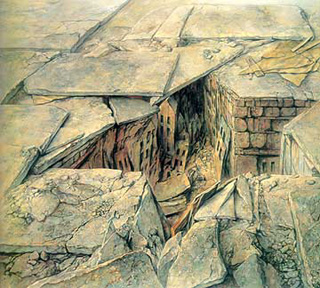In Ghetto
neither eye nor imagination has any way of escape. The horizon has disappeared
from this landscape without vistas; all signs of nature have vanished,
too. Holocaust history does not proclaim its message; we must evacuate
what we can from the ruins. Sheets of slate have moved aside as if from
a tomb, to reveal a star-shaped scar leading into an obscure tunnel lined
with the facades of crumbling structures—the former ghetto. Like
forlorn Dantes without benefit of Virgil, we are forced to pursue the
fate of European Jewry into the threatening depths below the inert stone
surface, following a narrow corridor between lifeless brick walls. But
our obligation is clear: memory and commemoration allow no other route.
Even the pale yellow cloth from Stars of David once worn on victims' breasts
points toward the ominous entry-way, as if all energy in the painting
were focused on this journey into the heart of holocaust darkness.
And what awaits us at the end? Tiny glimmers of reddish light, like the
eyes of demons, or the openings of twin crematorium ovens, beckon from
the abyss, an unholy glow that evokes for us the fate of a people. We
have the choice of moving the slabs of stone back in place and burying
them forever, or accepting the strenuous duty of mining the evidence of
their demise and keeping it steady in consciousness for our own and future
generations.
